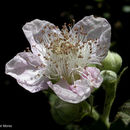More info for the terms:
apomixis,
fruit,
scarification,
seed,
stratificationThe Himalayan blackberry is capable of extensive and vigorous vegetative
regeneration [
32]. Sexual reproduction may also be important.
Reproductive versatility is well represented in the Rubus genus, with
sexual reproduction, parthenogenesis (development of the egg without
fertilization), pseudogamy (a form of apomixis in which pollination is
required), and parthenocarpy (production of fruit without
fertilization), occurring widely [
6]. The following types of
reproduction have been documented in blackberries: (1) sexual
reproduction, (2) nonreduction at meiosis on the female, male, or both
sides, (3) apomixis (seeds contain embryos of maternal, rather than
sexual origin) with segregation, (4) apomixis without segregation, and
(5) haploid parthenogenesis [
6]. These modes of asexual reproduction
contribute significantly to the aggressive, vigorous spread of
blackberries.
Vegetative regeneration: The mostly biennial stems of blackberries
typically develop from perennial rootstocks or creeping stems [
11].
Most species within the Rubus genus are capable of sprouting vigorously
from root or stem suckers, or rooting stem tips [
11]. Although not
specifically documented for the Himalayan blackberry, a similar response
is probable given the plant's morphology and the speed at which
postdisturbance establishment and spread occurs. The Himalayan
blackberry is known to spread extensively by trailing stems which root
at the nodes [
32]. Rapid vegetative spread occurs even in the absence
of disturbance.
Seed production: Most blackberries produce good seed crops nearly every
year [
3]. Immature fruit of the Himalayan blackberry is red and hard,
but at maturity, fruit becomes shiny black, soft, and succulent [
3].
Individual drupelets form an aggregate up to 0.8 inches (2 cm) in length
[
3,
24]. Cleaned seed averages approximately 147,000 per pound
(323,789/kg) [
3].
Germination: Blackberry seeds have a hard impermeable coat and a
dormant embryo [
3]. Consequently, germination is often slow. Most
blackberries require, as a minimum, warm stratification at 68 to 86
degrees F (20 to 30 degrees C) for 90 days, followed by cold
stratification at 36 to 41 degrees F (2 to 5 degrees C) for an
additional 90 days [
3]. These conditions are frequently encountered
naturally as seeds mature in summer and remain in the soil throughout
the cold winter months. Laboratory tests indicate that exposure to
sulfuric acid solutions or sodium hyperchlorite prior to cold
stratification can enhance germination [
3].
Seedbanking: Seeds of most blackberries can remain viable when stored
in the soil for a period of at least several years [
2]. However, the
specific length of viability has not been documented for the Himalayan
blackberry.
Seed dispersal: Seeds of blackberries are readily dispersed by gravity
and by many species of birds and mammals. The large succulent fruits
are highly sought-after and, after they mature, rarely remain on the
plant for long [
3]. A hard seedcoat protects the embryo even when the
seeds are ingested. Evidence suggests that the action of avian gizzards
and exposure to mammalian digestive acids provide scarification which
may actually enhance germination [
1].

